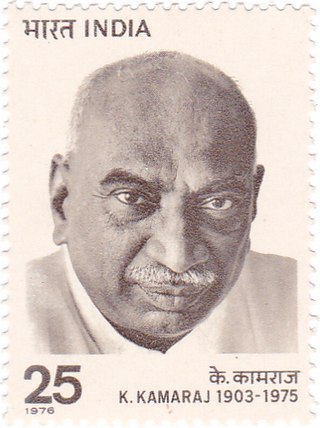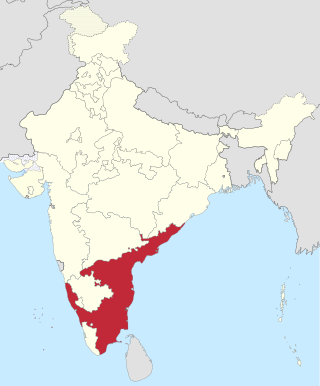Related Research Articles

The Dravida Munnetra Kazhagam is a political party based in the state of Tamil Nadu where it is currently the ruling party having a comfortable majority without coalition support and the union territory of Puducherry where it is currently the main opposition.
Thamizhaga Munnetra Munnani (1988-1989) was a short-lived political party found by veteran Tamil film actor Sivaji Ganesan in the year 1988. Sivaji Ganesan had a long running relation with many political parties, with his first movie itself being a propaganda movie of Dravida Munnetra Kazhagam.

Dravidar Kazhagam is a social movement founded by E. V. Ramasami, also called Thanthai Periyar. Its original goals were to eradicate the ills of the existing caste system including untouchability and on a grander scale to obtain a "Dravida Nadu" from the Madras Presidency. Dravidar Kazhagam would in turn give birth to many other political parties including Dravida Munnetra Kazhagam and later the All India Anna Dravida Munnetra Kazhagam.

Conjeevaram Natarajan Annadurai, popularly known as Anna, also known as Arignar Anna or Perarignar Anna, was an Indian Tamil politician who served as the fourth and last Chief Minister of Madras State from 1967 until 1969 and first Chief Minister of Tamil Nadu for 20 days before his death. He was the first member of a Dravidian party to hold either post.
The anti-Hindi-imposition agitations in Tamil Nadu were a series of agitations that happened in the Indian state of Tamil Nadu during both pre- and post-independence periods. The agitations involved several mass protests, riots, student and political movements in Tamil Nadu concerning the official status of Hindi in the state.
Dravidian nationalism, or Dravidianism, developed in Madras Presidency which comprises the four major ethno-linguistic groups in South India. This idea was popularized during the 1930s to 1950s by a series of small movements and organizations that contended that the South Indians formed a racial and a cultural entity that was different from the North Indians. Dravidianists have claimed that the Brahmins and other upper castes were originally Aryan migrants from the north, and that they imposed their language, Sanskrit, religion and heritage on the southern people.
Dravida Nadu was the name of a proposed sovereign state demanded by the Justice Party led by the founder of the self-respect movement, E.V. Ramasamy Periyar, and the Dravida Munnetra Kazhagam (DMK) led by C. N. Annadurai for the speakers of the Dravidian languages in South India.
Politics of Tamil Nadu is the politics related to the Indian state of Tamil Nadu.
Dravidian parties include an array of regional political parties in the state of Tamil Nadu, India, which trace their origins and ideologies either directly or indirectly to the Justice Party and the Dravidian movement of C. Natesanar and Periyar E. V. Ramasamy. The Dravidian movement was based on the linguistic divide in India, where most of the Northern Indian, Eastern Indian and Western Indian languages are classified as Indo-Aryan, whereas the South Indian languages are classified as Dravidian. Dravidian politics has developed by associating itself to the Dravidian community. The original goal of Dravidian politics was to achieve social equality, but it later championed the cause of ending the domination of North India over the politics and economy of the South Indian province known as Madras Presidency.
Erode Venkatappa Krishnasamy Sampath(c. 5 March 1926 – 23 February 1977), usually referred to as E. V. K. Sampath was a prominent politician from Tamil Nadu, India. He was an advocate of the Dravidian Movement of Periyar E. V. Ramasamy and was considered by some as his political heir. He later split from Periyar's Dravidar Kazhagam to form Dravida Munnetra Kazhagam (DMK) along with C. N. Annadurai. In spite of being one of the founders of DMK he later left and formed his own party, by the name, Tamil National Party. Nevertheless, he later merged his party with the Indian National Congress. He is a former Member of Parliament from the constituency of Namakkal.
Dravidian parties rose to power and prominence in the political stage of Tamil Nadu, a state in India, in the 1960s. The rise in power and political support was gradual until Dravida Munnetra Kazhagam (DMK), a Dravidian party, formed the government in the state in 1967. Although since the 1970s the Dravidian parties have met with many break-aways and have taken rival stances against each other, the seat of power in Tamil Nadu has been with one or another Dravidian party. The increase in popularity of the Dravidian parties in the 1960s is attributed to several factors, including the fall of popularity of the Congress Government in the centre and the north–south disparity, as claimed by the Dravidian politics. The series of events climaxed with anti-Hindi agitation which led to the downfall of popularity of the then Indian National Congress government in the state and the eventual rise of Dravidian parties to power.
Tamil cinema has played a vital role in Dravidian politics in the South Indian state of Tamil Nadu. Films have been influential in Indian politics since the days of the British Raj, when movies were used for anti-British propaganda. Nevertheless, the leaders of the Indian National Congress viewed movie media with contempt. It was the Dravida Munnetra Kazhagam (DMK), a Dravidian party, that made extensive use of this media for propaganda purposes. Adversaries of Dravidian parties despised the use of films and screen popularity for political gain, and Congress leaders like K. Kamaraj questioned the possibility of movie stars forming governments.

The fifth legislative assembly election of Tamil Nadu was held in March 1971. Dravida Munnetra Kazhagam was re-elected, after its first victory under the leadership of C N Annadurai in 1967. This was the first time M. Karunanidhi, contested as the leader of DMK party won the election, since he assumed Chief Ministership for the first time, after the death of C N Annadurai. Karunanidhi had emerged successfully in the leadership crisis with other party leaders M. G. Ramachandran, and Nedunchezhiyan, which ensued after the death of C. N. Annadurai. The main opposition party in the election was Indian National Congress (Organisation) led by K. Kamaraj, whereas the Indian National Congress (Indira) faction aligned with Dravida Munnetra Kazhagam.

The fourth legislative assembly election of Madras State was held in February 1967. The Dravida Munnetra Kazhagam (DMK) led coalition under the leadership of C.N. Annadurai won the election defeating the Indian National Congress (Congress). Anti-Hindi agitations, the rising prices of essential commodities, and a shortage of rice were the dominant issues. K. Kamaraj's resignation as the Chief Minister in 1963, to concentrate on party affairs, along with persistent rumors of corruption had weakened the incumbent Congress Government. This was the second time after Communist Party of India winning Kerala assembly elections in 1957, for a non-Congress party to gain the majority in a state in India, and the last time that Congress held power in Tamil Nadu. It was the first time a party or pre-election alliance formed a non-Congress government with an absolute majority. It marked the beginning of Dravidian dominance in the politics of Tamil Nadu. Annadurai, who became the first non-Congress chief minister of post-independence Tamil Nadu, died in office in 1969 and V.R. Nedunchezhiyan took over as acting chief minister.

The second legislative assembly election to the Madras state was held on 31 March 1957. This was the first election held after the linguistic reorganization of Madras state in 1954. Indian National Congress and its leader K. Kamaraj won the election, and defeated its rival Dravida Munnetra Kazhagam. In 1954, due to the resignation of C. Rajagopalachari, for his controversial Kula Kalvi Thittam, the leadership of Congress was contested, between K. Kamaraj, and C. Subramaniam. Eventually, K. Kamaraj, won the support of the party, was elected leader and chief minister of Madras State in 1954. In a surprise move, he appointed both M. Bhaktavatsalam and C. Subramaniam, in his cabinet, allowing great unity amongst Congress, that ruled the state of Madras, for the next decade. This election saw future DMK leaders, M. Karunanidhi and K. Anbazhagan winning their first MLA seat in the legislative assembly.

The third legislative assembly election to the Madras state was held on 21 February 1962. The Indian National Congress party, led by K. Kamaraj, won the election. Dravida Munnetra Kazhagam made significant in-roads in the election and emerged as the second party for the first time by winning 50 seats. 1962 Election remains the most recent election in which Indian National Congress to form a majority Government in the State as its support was heavily declined due to rise of Dravidian political parties.
Late ShriS. Natarajan Udayar was an Indian politician and 3 time DMK MLA from Thanjavur Constituency. A close friend and supporter of Periyar E.V. Ramaswamy, he was an early member of Dravidar Kazhagam. His association with Aringar C N Annadurai made him part ways with E.V.R. politically and join Dravida Munnetra Kazhagam (DMK) as one of the earliest and founding members of DMK.
N. V. Natarajan was an Indian politician of the Dravida Munnetra Kazhagam (DMK) and Member of the Legislative Assembly of Tamil Nadu. He was a founding member of the DMK. He served as the Minister of Labour and Backward Classes in the Tamil Nadu government during 1969-75.

Madras State was a state of India during the mid-20th century. At the time of its formation in 1950, it included the whole of present-day Tamil Nadu, Coastal Andhra, Rayalaseema, the Malabar region of North and central Kerala, Bellary, South Canara and Kollegal. Coastal Andhra and Rayalaseema were separated to form Andhra State in 1953, while South Canara and Bellary districts along with the Kollegalam taluka of Coimbatore district were merged with Mysore State, and Malabar District with the State of Travancore-Cochin to form Kerala in 1956. Post State Reorganization in 1956, the remaining Madras State was renamed to Tamil Nadu on January 14, 1969.

The fifth legislative assembly election of Tamil Nadu was held in March 1971. Dravida Munnetra Kazhagam was re-elected, after its first victory under the leadership of C N Annadurai in 1967. This was the first time M. Karunanidhi, contested as the leader of DMK party won the election, since he assumed Chief Ministership for the first time, after the death of C N Annadurai. Karunanidhi had emerged successfully in the leadership crisis with other party leaders M. G. Ramachandran, and Nedunchezhiyan, which ensued after the death of C. N. Annadurai. The main opposition party in the election was Indian National Congress (Organisation) led by K. Kamaraj, whereas the Indian National Congress (Indira) faction aligned with Dravida Munnetra Kazhagam. This was the last election that had only 2 major parties in Tamilnadu. After the election, MGR was slowly cornered out of DMK, and finally he formed AIADMK, which has since then been the close equal of DMK.
References
- 1 2 3 4 5 Sampath, Iniyan. "Famil background". Archived from the original on 20 January 2008. Retrieved 20 January 2008.
- ↑ Kumar, Vinoj (8 June 2004). "Priest-less weddings in TN VIP families". Sify News. Archived from the original on 8 February 2005. Retrieved 20 January 2009.
- ↑ Subramaniam, V (9 October 1998). "Celebrating a half century". Frontline. Retrieved 20 January 2009.
- 1 2 Velayutham, Selvaraj (2008). Tamil Cinema: The Cultural Politics of India's Other Film Industry. Routledge. p. 74. ISBN 978-0-415-39680-6.
- ↑ Rajagopalan, Swarna (2001). State and Nation in South Asia. Lynne Rienner Publishers. pp. 152–154. ISBN 1-55587-967-5.
- ↑ Bukowski, Jeanie J; Swarna Rajagopalan (2000). Re-distribution of Authority. Greenwood Publishing Group. pp. 19–21. ISBN 0-275-96377-2.
- 1 2 Hardgrave, Robert. L (1979). Essays in the Political Sociology of South India. Usha, 1979 (Originally published by University of Michigan. p. 70. ISBN 978-81-7304-052-8.
- ↑ "Sivaji Ganesan". Upperstall. 22 July 2001. Retrieved 20 January 2009.
- ↑ Jayakanthan, Dandapani (2006). A Literary Man's Political Experiences. Read Books. pp. 111–113. ISBN 978-1-4067-3569-7.